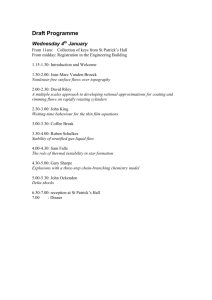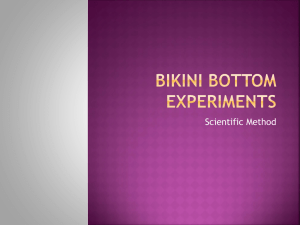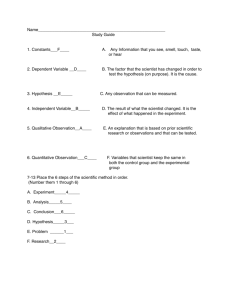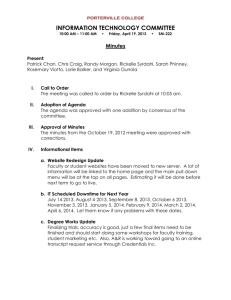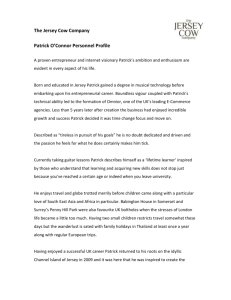honors biology summer assignment
advertisement
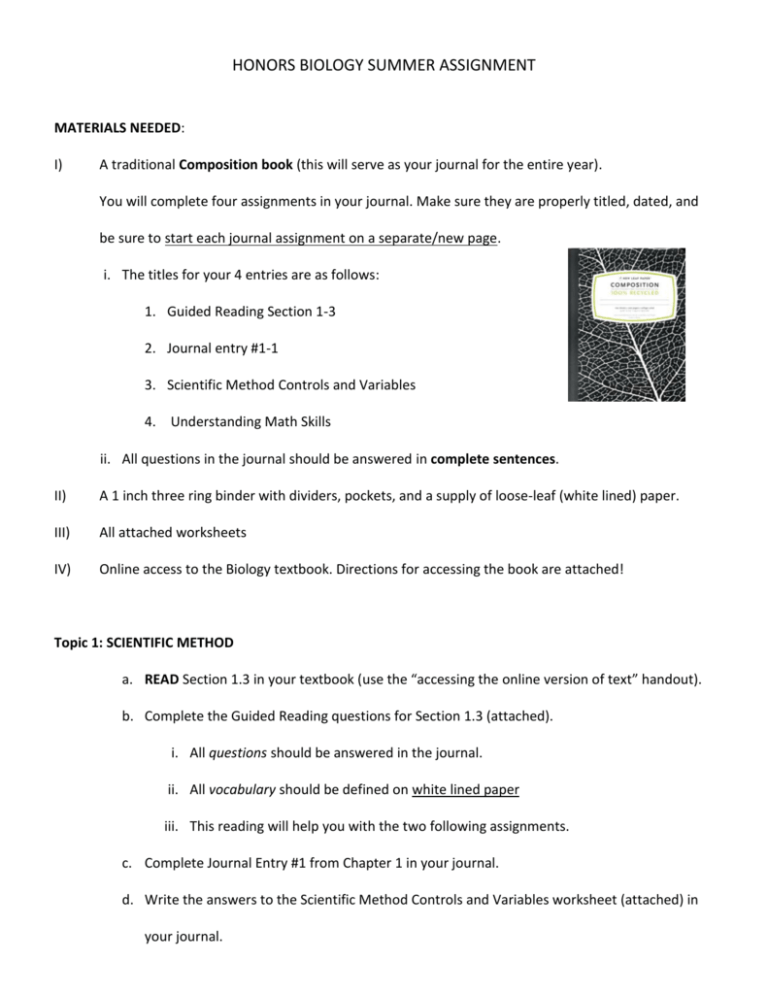
HONORS BIOLOGY SUMMER ASSIGNMENT MATERIALS NEEDED: I) A traditional Composition book (this will serve as your journal for the entire year). You will complete four assignments in your journal. Make sure they are properly titled, dated, and be sure to start each journal assignment on a separate/new page. i. The titles for your 4 entries are as follows: 1. Guided Reading Section 1-3 2. Journal entry #1-1 3. Scientific Method Controls and Variables 4. Understanding Math Skills ii. All questions in the journal should be answered in complete sentences. II) A 1 inch three ring binder with dividers, pockets, and a supply of loose-leaf (white lined) paper. III) All attached worksheets IV) Online access to the Biology textbook. Directions for accessing the book are attached! Topic 1: SCIENTIFIC METHOD a. READ Section 1.3 in your textbook (use the “accessing the online version of text” handout). b. Complete the Guided Reading questions for Section 1.3 (attached). i. All questions should be answered in the journal. ii. All vocabulary should be defined on white lined paper iii. This reading will help you with the two following assignments. c. Complete Journal Entry #1 from Chapter 1 in your journal. d. Write the answers to the Scientific Method Controls and Variables worksheet (attached) in your journal. Topic 2: WAYS TO REPRESENT AND INTERPRET DATA a. Read the Understanding Math Skills in your textbook i. use the “accessing the online version of text” handout to locate the readings b. Answer the following questions in your journal. Read the section: Make and Use Tables 1. Describe the components of a table. 2. Answer practice problem #2 at the end of the section. Read the section: Make and Use Graphs 3. What is a graph? 4. Why are graphs used? 5. What are the three types of graphs used in science? Read the section: Line graphs 6. What does a line graph show? 7. On a line graphs, where are the independent and dependant variables plotted? 8. Answer practice problems 3 and 4. Read the section: Bar graphs 9. What is displayed in a bar graph? 10. Answer practice problem #5. Read the section: Circle graphs 11. What does a circle graph show? 12. Carefully read the section on circle graphs then answer practice problem #6. Topic 3: Scientific word origins (use the “accessing the online version of text” handout to locate the terms) The prefixes and suffixes on this list are important not only to understanding biology words but words outside of biology as well, such as on the SAT’s. You should learn the meanings of these word origins and be prepared to be quizzed on them in the first week of school. ACCESSING THE ONLINE VERSION OF THE BIOLOGY HONORS TEXTBOOK Steps: 1. Go to www.biologygmh.com 2. In the box in upper left corner: Choose State: MA Click Student/Parent Choose Subject: Science 3. Next page: Click on Biology then Glencoe Biology 2009 4. Next page: Under Textbook resources click on StudentWorks Plus Online 5. On left side of next page, click on StudentWorks Plus Online again 6. Then click on it again on middle of screen. 7. Next page: Enter your access code: EAEE8C0300 click Submit and the book should open. IMP: If this code does not work, email me at khoey@saugus.k12.ma.us 8. For the Scientific Method assignment, do the following: a. Click on the Table of Contents tab at the top left. b. Click on Student Guide Chapter 1 Section 3: Methods of Science c. You need to read this section from pages 16-21 then complete the guided reading questions and vocabulary terms for that section. (on attached worksheet) 9. For the Understanding Math Skills assignment, do the following: a. Click on the Table of Contents tab at the top left. b. Click on Student Resources Skillbuilder Handbook c. Under the Math Skills section you are reading the following sections: i. Making and using tables (pg. 1115) ii. Making and using graphs (pg. 1115-1116) iii. Bar graphs and circle graphs (pg. 1117-1118) d. You need to answer the questions from these sections in your journal. The questions are on an attached worksheet. 10. For the Scientific Word Origins assignment, do the following: a. Click on the Table of Contents tab at the top left. b. Click on Student Resources Skillbuilder Handbook Scientific Word Origins GUIDED READING: Section 1.3 Honors Biology Directions: As you read Section 1.3 (pgs. 16-21), answer the questions below in complete sentences in your journal. Label the top of the page as Guided Reading 1.3. When noted (*), define any vocabulary terms on a separate sheet of paper (white lined). You can refer to the glossary of the book for definitions. METHODS OF SCIENCE I) Ask a Question * Define observation, inference, and scientific method on the vocabulary sheet. II) Form a hypothesis * Define hypothesis and serendipity on the vocabulary sheet. 2. Explain what happens when a hypothesis is supported by data. What happens if a hypothesis is not supported by data? III) Collect the Data * Define experiment, control group and experimental group on the vocabulary sheet. * Define independent variable, dependant variable, and constant on the vocabulary sheet. 3. For the kittiwake experiment, write a paragraph identifying the following: The hypothesis, the control group, the experimental group, the independent variable, and the dependant variable. * Define data on the vocabulary sheet. 4. Differentiate between quantitative and qualitative data. 5. What quantitative data was gathered in the kittiwake experiment? IV) Analyze Data 6. Explain the relationship between the mass of anole lizards and time as shown in the graph in Figure 1.17. What do you think will be the mass of the anole at 21 days? Explain your answer. V) Report Conclusions Journal Entry: Chapter 1, Entry #1 Controlled experiments You won’t believe what happened in school today!! I got a D in chemistry. My chemistry teacher assigned a project to conduct a controlled experiment of our choice. I chose to test which type of laundry detergent was more effective at removing stains: Tide or Wisk. Here is a description of my experiment. I got an old white T-shirt and a pair of jeans. I put a ketchup stain on the T-shirt and then slid on the lawn to get a grass stain on the jeans. Then, I put one scoopful of powdered Wisk on the ketchup stained T-shirt and two capfuls of liquid Tide on the grass stained pants. I threw the jeans in the washing machine in cold water for 10 minutes. Then, I washed the T-shirt in warm water for 6 minutes (since it’s smaller). Then, I put both the T-shirt and jeans in the dryer for 10 minutes. When I removed the clothes, the grass stain was lighter than the ketchup stain so I concluded that Tide was the better detergent. 1. Apparently, my teacher did not like my experiment. He said that it was not “controlled”. What did I do wrong??? Describe at least 5 mistakes I made in conducting this experiment. 2. Describe, in detail, the controlled experiment you would conduct to properly test the effectiveness of the two laundry detergents. Name _________________________________________________ Date ______________ Per _______ SCIENTIFIC METHOD WS: Controls and Variables Biology Sponge Bob and his Bikini Bottom pals have been busing doing a little research. Read the description for each experiment and answer the questions. 1. Patty power Mr. Krabbs wants to make Bikini Bottom a nicer place to live. He has created a new sauce that he thinks will reduce the production of body gas associated with eating crabby patties from the Krusty Krab. He recruits 100 customers with a history of gas problems. He has 50 of them (Group A) eat the crabby patties with the new sauce. The other 50 (Group B) eat crabby patties without the sauce. Two hours after eating the crabby patties, 30 customers in Group A reported having fewer gas problems and 8 customers in Group B reported having fewer gas problems. a. Which people are in the control group? b. What is the independent variable? c. What is the dependant variable? d. What should Mr. Krabb’s conclusion be? 2. Slimotosis Sponge Bob notices his pal Gary is suffering from slimotosis, which occurs when the shell develops a nasty slime and gives off a horrible odor. His friend Patrick tells him rubbing seaweed on the shell is the perfect cure. Sandy tells him that drinking Dr. Kelp will be a better cure. Sponge Bob decides to test the cures by rubbing Gary with seaweed for 1 week and having him drink Dr. Kelp that same week. After the week of treatments, the slime is gone and Gary’s shell smells better. Sponge Bob concludes that both treatments work. a. Is Sponge Bob’s conclusion correct? Explain why or why not. b. Describe a better way to test Patrick and Sandy’s hypotheses. 3. Marshmallow muscles Larry was told that a certain muscle cream was the newest best thing on the market and claims to double a person’s muscle power when used as part of a muscle-building workout. Interested in this product, he buys the special muscle cream and recruits Patrick and SpongeBob to help him with an experiment. Larry develops a special marshmallow weight lifting program for Patrick and SpongeBob. He meets with them once every day for a period of 2 weeks and keeps track of their results. Before each session, Patrick’s arms and back are lathered in the muscle cream, while SpongeBob’s arms and back are lathered with the regular lotion. a. Which person is the control group? b. What is the independent variable? c. What is the dependant variable? d. Examine the data table. What should Larry’s conclusion be? Explain your answer. Number of marshmallows lifted Time Patrick SpongeBob Initial 18 5 After 1 week 24 9 After 2 weeks 33 17 4. Microwave miracle Patrick believes that fish that eat food exposed to microwaves will become smarter and would be able to swim through a maze faster. He decides to perform an experiment by placing fish food in a microwave for 20 seconds. He has the fish swim through a maze and records the time it takes for each one to make it to the end. He feeds the special food to 10 fish and gives regular food to 10 others. After 1 week, he has the fish swim through the maze again and records the times for each. a. What was Patrick’s hypothesis? b. Which fish are in his control group? c. What is the independent variable? d. What is the dependant variable? e. Examine the data tables. What should Patrick’s conclusion be? 5. Squidward’s symphony Squidward loves playing his clarinet and believes it attracts more jellyfish than any other instrument he has played. In order to test his hypothesis, Squidward played a song on his clarinet for 5 minutes and counted the number of jellyfish he saw in his front yard. After the jellyfish left, he played the song again. He played the song a total of 3 times on his clarinet and repeated the experiment using a flute and a guitar. He also recorded the number of jellyfish he observed when he was not playing an instrument. His results are shown in the chart. Number of Jellyfish/Instrument Trial No Music Clarinet Flute Guitar a. What is the independent variable? 1 5 15 5 12 b. What is the dependant variable? 2 3 10 8 18 c. What is (are) the control group(s)? 3 2 12 9 7 d. What is (are) the experimental group(s)? e. What should Squidward’s conclusion be? 6. Super bubbles Patrick and Sponge Bob love to blow bubbles! Patrick found some Super Bubble Soap at the SailMart. The ads claim that Super Bubble Soap will produce bubbles that are twice as big as bubbles made with regular bubble soap. Patrick and Sponge Bob made up two samples of bubble solution. Sample 1 was made with 5 oz. of Super Bubble Soap and 5 oz. of water. Sample 2 was made with 5 oz. of water and 5 oz. of regular bubble soap. Patrick and Sponge Bob used their favorite bubble wands to blow 4 different bubbles and did their best to measure the diameter of each one. The results are shown in the chart. a. What did the Super Bubble ads claim? Bubble b. What is the independent variable? Super Bubble Regular Soap (Sample 1) (Sample 2) c. What is the dependent variable? 1 16 cm 12 cm d. What should Patrick and Sponge Bob conclude the 2 10 cm 5 cm 3 15 cm 15 cm 4 14 cm 10 cm claims made by Super Bubble soap?
